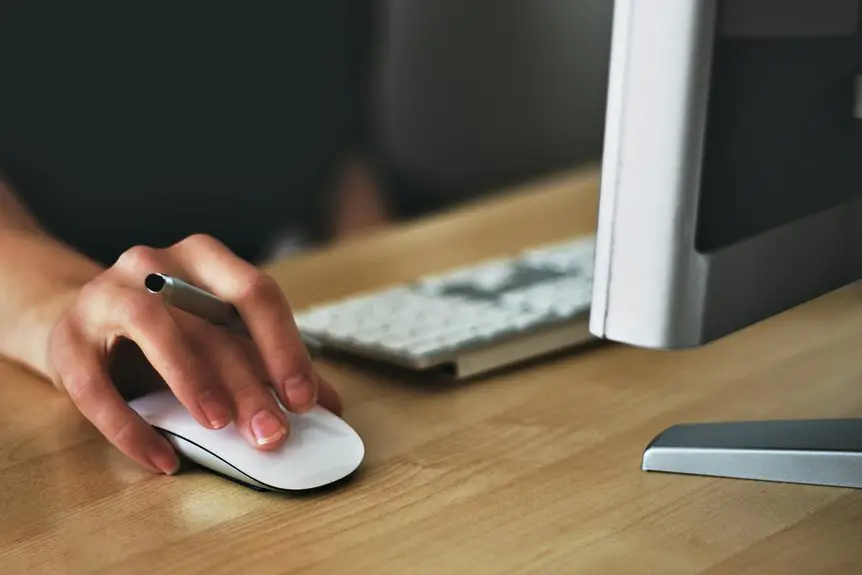If your hand’s hurting from mouse use while working from home, it could be due to poor ergonomics, repetitive motions, or muscle strain. Adjusting your workspace can help—make sure your chair and desk are at the right height and your mouse is close to your keyboard. Choosing an ergonomic mouse can also reduce discomfort. Taking regular breaks and doing stretching exercises will help relieve tension. Stick around to learn more tips for improving your hand health.
Key Takeaways
- Poor grip and awkward wrist positions while using a mouse can lead to hand pain over time.
- Ensure your workspace is ergonomically set up to reduce strain on your hands and wrists.
- Choose a mouse that fits your hand comfortably and supports natural wrist positioning.
- Regular breaks and stretching exercises every 30 minutes can help alleviate discomfort.
- Mindful mouse usage, such as minimizing excessive clicking, is crucial for hand health.
Understanding the Causes of Hand Pain From Mouse Use
While you mightn’t realize it, the way you use your mouse can significantly impact your hand health. Poor grip, excessive clicking, and awkward wrist positions can lead to discomfort and pain.
If you’re gripping your mouse too tightly, it can strain your muscles and tendons, causing irritation over time. Additionally, repetitive movements can contribute to conditions like carpal tunnel syndrome, where pressure on your wrist nerves causes pain and numbness.
You might also find that an improper hand position—like having your wrist bent at an awkward angle—can exacerbate this pain. Being mindful of how you interact with your mouse is essential for maintaining hand health and preventing long-term issues that could affect your productivity and daily life.
Evaluating Your Workspace Ergonomics
To guarantee your hand health while using a mouse, evaluating your workspace ergonomics is essential.
Evaluating your workspace ergonomics is crucial for maintaining hand health while using a mouse.
You want to make certain everything’s set up to reduce strain on your hands and wrists. Here are four key aspects to take into account:
- Chair Height: Adjust your chair so your feet rest flat on the floor, with your knees at a 90-degree angle.
- Desk Height: Your desk should allow your elbows to be at the same height as your keyboard, keeping your wrists straight.
- Mouse Position: Position your mouse close to your keyboard to avoid reaching, which can cause discomfort.
- Monitor Height: Set your monitor at eye level to prevent leaning forward, which can strain your neck and shoulders.
Make these adjustments for a healthier workspace!
Tips for Choosing the Right Mouse
Choosing the right mouse can make a significant difference in your comfort and productivity, especially if you’re spending long hours at your computer.
Start by considering the size and shape; a mouse that fits your hand comfortably can reduce strain. Look for ergonomic designs that support your wrist and promote natural hand positioning.
Next, consider the weight and sensitivity. A heavier mouse can provide stability, while adjustable sensitivity helps you navigate efficiently. Wireless options offer freedom of movement, but guarantee battery life meets your needs.
Finally, test different styles, like vertical or trackball mice, to see what feels best for you.
Taking the time to choose the right mouse can lead to a more comfortable and efficient work experience.
Effective Exercises to Relieve Hand Discomfort
Even with the right mouse, you might still experience hand discomfort from prolonged use. To alleviate that pain, try these effective exercises:
- Wrist Flexor Stretch: Extend one arm in front, palm up, and gently pull back on your fingers with the other hand.
- Finger Taps: Tap each finger to your thumb, one at a time, to improve dexterity and circulation.
- Hand Squeeze: Use a stress ball or a soft foam ball, squeezing it tightly for a few seconds, then release.
- Wrist Rolls: Rotate your wrists in circles, first clockwise, then counterclockwise, to relieve tension.
Incorporating these exercises into your routine can provide relief and help keep your hands feeling better throughout the workday.
Preventive Measures for Long-Term Hand Health
While using a mouse is often unavoidable in today’s digital world, taking proactive steps can greatly reduce the risk of hand pain. Here are some preventive measures you can incorporate into your daily routine:
| Measure | Description | Benefits |
|---|---|---|
| Ergonomic Mouse | Choose a design that fits your hand | Reduces strain |
| Adjustable Desk | Use one that allows you to change height | Promotes better posture |
| Regular Breaks | Take short breaks every hour | Reduces fatigue |
| Hand Stretching | Perform stretches every 30 minutes | Increases flexibility |
Frequently Asked Questions
Can Using a Laptop Touchpad Cause Similar Hand Pain?
Yes, using a laptop touchpad can cause similar hand pain. It often leads to awkward wrist positions and repetitive motions, which strain your muscles. Adjusting your setup and taking breaks can help alleviate discomfort.
What Are the Signs of Mouse-Related Repetitive Strain Injuries?
If you’re experiencing persistent pain, numbness, or tingling in your fingers, wrists, or forearms, it could indicate a mouse-related repetitive strain injury. You should pay attention to these signs and adjust your habits accordingly.
How Often Should I Take Breaks to Prevent Hand Pain?
To prevent hand pain, take breaks every 30 to 60 minutes. Stand, stretch your fingers, and shake out tension. These short pauses help maintain circulation and reduce strain, keeping your hands comfortable and healthy.
Is There a Specific Mouse Type Better for Small Hands?
If you’ve got small hands, consider a compact or ergonomic mouse designed specifically for smaller grips. These options can enhance comfort and control, reducing strain during those long hours of work on your computer.
Can Stress Contribute to Hand Pain While Using a Mouse?
Yes, stress can contribute to hand pain while using a mouse. When you’re tense, your muscles tighten, leading to discomfort. Try to relax and take breaks to ease both stress and hand strain.
